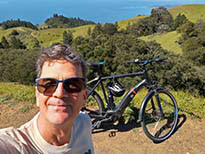In my post earlier in the month I said I thought this trail cam location had potential, and I sorta cursed when I later got this image of a bobcat apparently bolting through so quickly it's head was cut off before the cam could jump into action. I have the cam set to fire off three frames when it's triggered. This was frame number one, and it seemed impossible to me that the bobcat wouldn't have triggered the camera sooner. I didn't figure out how it could have happened, aside from an insanely slow camera trigger, until I returned to the scene yesterday, July 31.
I had two cams set up, with one on the log and the other on this pool. For part of the month I had both photo and video working on this pool, but I ended up with so many useless frames that I turned off the video. It's a lot more time-consuming to review video in Lightroom than to review still images, and video also eats up the trail cam batteries more quickly.
What kind of owl is this? Check out the video below to see what happens next.
Yesterday I brought a third trail camera along, even though I wasn't sure where I wanted to place it. Biking up toward Rock Spring I returned to the scene of my recent fox encounter to look for anything obvious about the location that would be of enough interest to foxes that I could expect to catch them again. Seeing nothing more than a faint animal trail on the very steep slope, I didn't think it was worth setting up a cam there.
The log cam has been catching foxes fairly often anyway. The video shows a nice little interaction between two foxes who meet in apparent joy.
All the other usual suspects also showed up, including mice and band-tailed pigeons, which are briefly included in the video.
When I swapped out the memory cards and batteries yesterday, I also re-synchronized the timestamp on each of the cams. Unfortunately, each cam gains time at a different speed. This image of the fox heading downstream past the pool and toward the log was stamped at 9:51 p.m.
And this one of the fox crossing the log was stamped at 10:04 p.m. I doubt the fox actually dawdled at the pool for 13 minutes, but who knows. I wish the timestamps were more accurate.
All three bobcat captures (July 9, 23 & 26) occurred in daytime. I suspect the bobcat in this image leaped up to the log from the downstream (left) side. More of this cat appears in the video.
What I also found yesterday is a nearby upstream ledge which probably explains how the bobcat's head was already cut off in the first frame at the top of this post. Unlike the foxes, the bobcat doesn't traverse the log from end to end, but leaps onto it.
The foxes always seem to get on the log from one of the ends, but they sometimes exit by jumping off. This one appears to be checking out something of interest at the pool.
Here it is almost noon when the bobcat comes down for a drink. Unfortunately I had turned off the video on this cam, but the third shot in the series clearly shows the cat dipping its head to drink.
Having found nowhere better to put the third cam, I decided to set it up to overlook the pool and the log. I set its video to run for six seconds instead of the twelve that runs on the log cam, and already I regret doing that. I'm thinking about going back up tomorrow to set all the videos for 20 seconds.
Even though it will be a pain to go through them all, and I'll have to swap batteries more often, it's probably worth the trouble to get the one-in-a-hundred (or several hundred) captures that would make the enterprise more fun and interesting.
Mt. Tam was gorgeous yesterday, with warm sunshine (which we haven't experienced in my fog-bound Sunset District neighborhood in recent memory) and best of all, hardly any bugs. On my last trip to swap out memory cards and batteries, I rushed through the task, swatting at various gnats and flies that swarmed around my face and tried to bite my legs. This time I sat rapturously next to the creek with a breeze singing in the trees and numerous birds flying about, in no hurry to leave.
* * *

























































